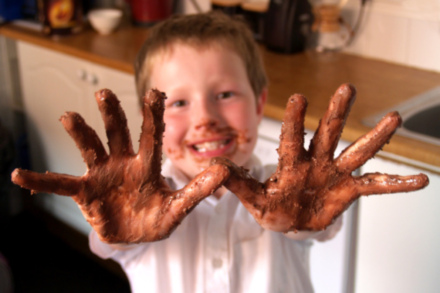
Chocolate hands
With the Christmas holidays upon us, the carpet cleaning experts at ServiceMaster Clean offer some simple advice on how to deal with the inevitable spills and stains that follow kids around.
We all know that sticky fingers get wiped on carpets and furniture, and the next masterpiece usually misses the canvas and hits the floor. With chocolate treats in continuous supply and little ones putting pen to paper for their homemade cards, marks and stains can be the cause of much angst for parents and grandparents.
1. No matter what the spill, the first tip is to blot, don't rub. Plain white kitchen towel is best, and the sooner you act, the better. For fruit juices, rinse with cold water then dab with warm water containing a small amount of washing powder, then rinse again. A towel is good for this.
2. If that selection box has been shared with the carpet, don't panic. Scrape away any excess chocolate before following the steps above. If the stain remains, use a white vinegar solution instead of detergent. Once rinsed, place a white cloth over the stain and weigh it down until dry.
3. With bikes and scooters top of many Christmas lists this year, a few bumps and scrapes are probably par for the course. Cuts and grazes can easily leave marks on your floors and upholstery and here biological washing powder in warm water is your friend in helping to remove the worst of a blood stain. Dab, don't rub, and make sure you rinse as the soap solution could attract dirt if not cleaned away.
4. For a stubborn stain you can keep it damp (not wet) for several hours with a damp towel weighted down by a heavy book, wrapped in cling film to protect it. This is like soaking your pans in the sink.
5. If all else fails you can turn to the Christmas tipple. Both Vodka and Gin work well on many stains, including felt tip pen and some glue. However, glue can be a real challenge and might need professional help.
In order to tackle those little, unexpected accidents, here are ServiceMaster Clean's top seven items you should have in your cleaning kit.
1. A clean cloth - or plain white paper towels for dabbing up spills.
2. Vodka - a dab of vodka works well on most stains, dab and blot until the stain is reduced or removed.
3. Bi-carbonate of Soda - this is great for removing or reducing odours. Sprinkle over your carpet and gently work in. Leave for a day and then thoroughly vacuum away.
4. Soap flakes and plain soap - with a little water this will gently remove various stains including mud.
5. White vinegar - handy for removing all kinds of stains and odours. Most things in nature are acidic and it’s gentler to remove marks in the same pH level, therefore it’s often safer to try a little white vinegar first before moving onto something stronger such as…
6. Household ammonia - great for all kinds of stains where mild alkalinity helps. Always dilute according to the instructions on the bottle and ALWAYS rinse afterwards.
7. A small soft brush - perfect for loosening dirt or gently Cleaning a tile floor.
Read more: http://www.femalefirst.co.uk/parenting/parenting+advice+Hints+and+Tips+to+Tackle+Spills+and+Stains+at+Christmas-271155.html#ixzz2ng7KAFyq



